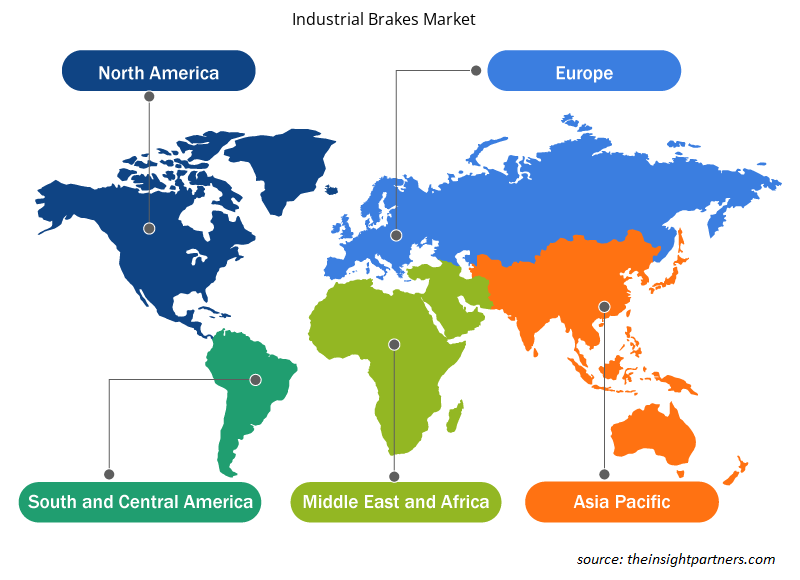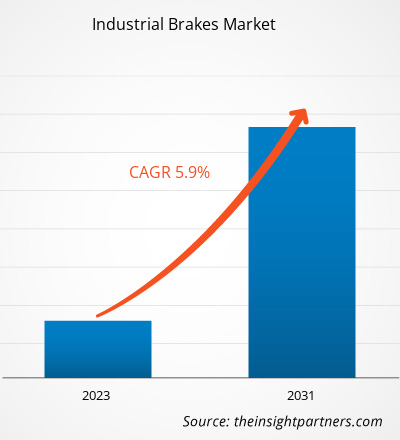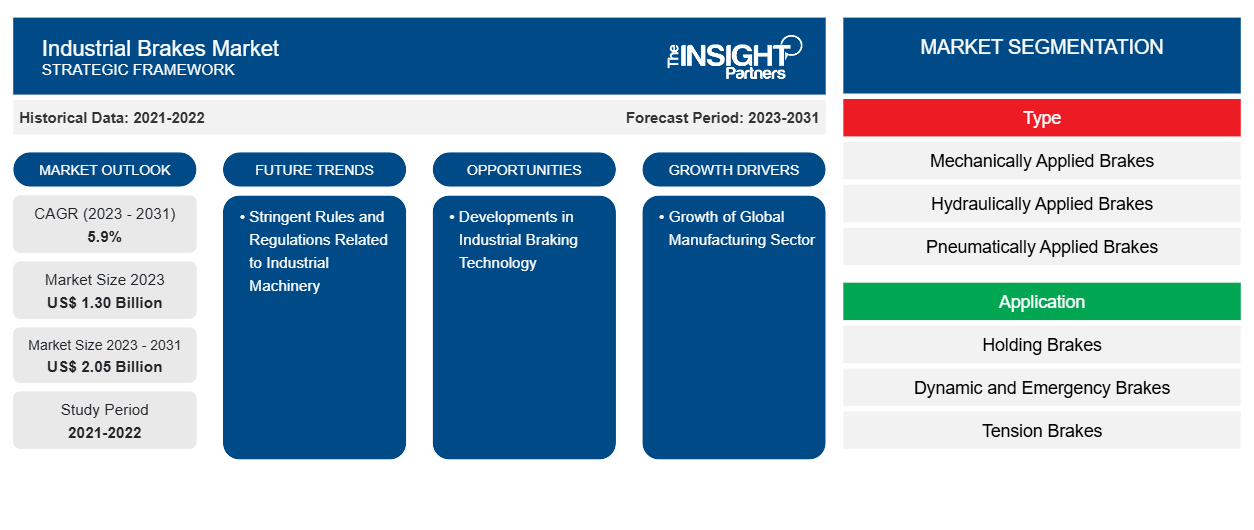Si prevede che il mercato dei freni industriali raggiungerà i 2,05 miliardi di dollari entro il 2031, rispetto agli 1,30 miliardi di dollari del 2023. Si prevede che il mercato registrerà un CAGR del 5,9% nel 2023-2031.
Un freno industriale è un dispositivo di attrito utilizzato per arrestare un carico di inerzia rotante o per mantenere un componente in una posizione fissa. Nella maggior parte dei casi, il carico di inerzia è causato da molti componenti rotanti che devono essere arrestati. Per rallentare qualsiasi cosa, trasformano l'energia cinetica creata dall'attrito tra due superfici in calore. I freni industriali differiscono dai freni delle auto in quanto sono utilizzati in una varietà di macchine industriali. I freni industriali funzionano in tutte le situazioni meteorologiche, richiedono meno manutenzione grazie al minor numero di componenti in movimento e sono facili da modificare per varie applicazioni. Durante il periodo di previsione, è probabile che tutti questi motivi aumentino la domanda di freni industriali in tutto il mondo.
I freni industriali offrono numerosi vantaggi, uno dei quali è il basso numero di parti e pezzi di ricambio necessari. Altri vantaggi includono una facile igiene grazie al design monoblocco, un elevato ritorno sull'investimento dovuto alla maggiore durata dei freni industriali e la capacità di lavorare in situazioni difficili. Inoltre, si prevede che la crescente industrializzazione e i crescenti investimenti governativi nei settori industriali per promuovere la produzione avranno un'influenza sostanziale sul mercato dei freni industriali durante il periodo previsto.
Analisi del mercato dei freni industriali
Gli stakeholder chiave nell'ecosistema del mercato globale dei freni industriali includono fornitori di materie prime, produttori di freni industriali e utenti finali. La crescente domanda di freni avanzati nelle unità di produzione in diversi settori è uno dei fattori principali che guidano la domanda di freni industriali. I fornitori di materie prime offrono diverse unità per vari tipi di freni industriali, come freni a attuazione meccanica, freni a attuazione idraulica, freni a attuazione pneumatica e freni a attuazione elettrica. Oltre a ciò, l'uso di freni industriali da parte degli utenti finali per facilitare offrendo la velocità, l'accelerazione e la decelerazione necessarie alle apparecchiature industriali sta influenzando ulteriormente la domanda di freni industriali.
Panoramica del mercato dei freni industriali
I freni industriali sono ampiamente utilizzati nella produzione di macchinari pesanti e veicoli industriali come escavatori, bulldozer, terne, minipale e tra gli altri. I freni industriali sono utilizzati anche in varie apparecchiature per la lavorazione alimentare, dispositivi medici , macchine idrauliche in impianti industriali, produzione automobilistica e altre applicazioni. Il mercato dei freni industriali ha la quota maggiore nella regione Asia-Pacifico grazie a diversi produttori di piccole e medie dimensioni seguiti dai principali attori. Alcuni dei produttori di freni industriali nella regione Asia-Pacifico includono Altra Industrial Motion Corp., ADVICS CO., LTD.; Akebono Brake Industry Co., Ltd., AMETEK Inc., Eaton Corporation plc; Emco Precima Engineering Pvt Ltd. e tra gli altri. Questi produttori forniscono freni industriali a vari settori in tutto il mondo.
Personalizza questo report in base alle tue esigenze
Riceverai la personalizzazione gratuita di qualsiasi report, comprese parti di questo report, o analisi a livello nazionale, pacchetto dati Excel, oltre a usufruire di grandi offerte e sconti per start-up e università
-
Scopri le principali tendenze di mercato in questo rapporto.Questo campione GRATUITO includerà analisi di dati che spaziano dalle tendenze di mercato alle stime e alle previsioni.
Driver e opportunità del mercato dei freni industriali
Crescita del settore manifatturiero globale
Dall'inizio della Rivoluzione industriale, i progressi tecnologici hanno portato a un'enorme impennata delle capacità di produzione industriale; di conseguenza, la produzione è in crescita in tutto il mondo. Secondo PricewaterhouseCoopers (PwC), economie in crescita, qualità della manodopera, politiche fiscali, ambienti normativi e prezzi dei trasporti e dell'energia sono i fattori che hanno catalizzato il ritorno di questo settore. Come risultato dell'espansione del settore manifatturiero, anche i mercati dipendenti, compresi i fornitori di apparecchiature meccaniche , stanno fiorendo. Con l'emergere di nuove categorie di consumatori nei paesi in via di sviluppo, è probabile che i produttori di tutto il mondo abbiano nuove prospettive significative; inoltre, le innovazioni generano nuove richieste, spingendo così l'uso di apparecchiature e sistemi moderni nelle unità di produzione.
Norme e regolamenti rigorosi relativi ai macchinari industriali
Le macchine sono necessarie per il processo di produzione, ma incidenti durante il loro funzionamento possono causare ustioni, cecità e amputazioni. La salvaguardia, la standardizzazione delle procedure operative e una formazione approfondita possono aiutare a mantenere il personale al sicuro e protetto. Governi e organizzazioni in tutto il mondo stanno trasformando le loro operazioni implementando standard di emissione e sicurezza negli impianti di produzione. Le multe dell'Occupational Safety and Health Administration (OSHA) per la violazione degli standard di sicurezza hanno totalizzato oltre 50 milioni di dollari nell'anno fiscale 2018. Di conseguenza, il governo degli Stati Uniti sta sviluppando un piano normativo a lungo termine per la prosperità del settore manifatturiero, aumentando il suo contributo al PIL.
Sviluppi nella tecnologia di frenata industriale
Quando si progettano sistemi di apparecchiature, è fondamentale pensare a come il sistema frenante influirà sul funzionamento delle macchine successive. I freni fail-safe aiutano a interrompere rapidamente il movimento della macchina in caso di incidenti, guasti alle prestazioni o interruzioni di corrente, tra gli altri. Le aziende stanno anche lavorando su freni a rilascio idraulico che sono sistemi frenanti a molla che utilizzano energia idraulica per produrre coppia regolabile. La necessità di freni industriali è elevata negli argani per miniere, nelle gru a ponte, nei sistemi di laminazione dell'acciaio e in altri dispositivi simili. Inoltre, i settori dell'immagazzinamento, medico, delle acciaierie e della lavorazione alimentare hanno un potenziale significativo per il mercato dei freni industriali. Le aziende stanno lavorando attivamente su freni a molla con elevate energie di frenata consentite, coppie elevate e resistenza all'usura. Ad esempio, Kor-Pak, un OEM e distributore di freni e frizioni industriali, sta sviluppando sistemi frenanti end-to-end per i settori minerario e manifatturiero.
Analisi della segmentazione del rapporto di mercato sui freni industriali
I segmenti chiave che hanno contribuito alla derivazione dell'analisi di mercato dei freni industriali sono il tipo di temperatura, il tipo di magazzino e l'applicazione.
- In base al tipo, il mercato è suddiviso in freni applicati meccanicamente, freni applicati idraulicamente, freni applicati pneumaticamente, freni applicati elettricamente e altri. I freni applicati meccanicamente applicano forza, più comunemente attrito, per rallentare o fermare una macchina o un oggetto dal muoversi. La forza viene applicata a un corpo che è in movimento rotatorio o lineare, come un asse, un albero o una ruota. I freni meccanici sono utilizzati nella movimentazione dei materiali, nella produzione e in altre applicazioni di trasmissione di potenza e sono più comunemente associati alle automobili. Per innestare e disinnestare gli alberi, i freni meccanici sono spesso utilizzati insieme a una frizione meccanica. Per decelerare, i freni basati sull'attrito utilizzano una sostanza ruvida e dura (una guarnizione del freno) che viene serrata o forzata contro un corpo in movimento. La frenata basata sull'attrito crea molto calore e un rumore considerevole, che degrada le aree superficiali interessate.
- In base all'applicazione, il mercato globale dei freni industriali è suddiviso in freni di stazionamento, freni dinamici e di emergenza e freni di tensione. I freni di stazionamento del motore sono responsabili del mantenimento della posizione del motore quando lo stadio di potenza è spento. Il freno di stazionamento non è né una caratteristica di sicurezza né un freno di manutenzione. Questo freno è utilizzato nell'automazione di fabbrica, nelle apparecchiature mediche, negli ascensori e nelle scale mobili, nelle attrezzature edili, nella robotica e nelle attrezzature per macchine utensili. Molte aziende offrono freni di stazionamento per varie applicazioni e ambienti industriali. Ad esempio, Vortex Engineering Works fornisce freni di stazionamento a molla per le operazioni nel settore tessile.
- A seconda del settore verticale, il mercato è suddiviso in produzione, metallurgia e estrazione mineraria, edilizia, produzione di energia, nautica e spedizioni e altri.
Analisi della quota di mercato dei freni industriali per area geografica
L'ambito geografico del rapporto di mercato sui freni industriali è suddiviso principalmente in cinque regioni: Nord America, APAC, Europa, Medio Oriente e Africa e SAM.
Gli sviluppi persistenti nel settore industriale nei paesi dell'Asia Pacifica contribuiscono alla loro prosperità economica. Questo cambiamento ha portato a un aumento della ricchezza, dell'urbanizzazione e dell'espansione della popolazione. Inoltre, l'Asia Pacifica rappresenta una parte sostanziale del consumo energetico globale, con il settore industriale che rappresenta la maggior parte del consumo energetico regionale. La regione comprende 58 economie e ospita oltre il 60% della popolazione mondiale. Secondo il rapporto annuale 2018 dell'ADB, la sua quota nel prodotto interno lordo a parità di potere d'acquisto globale (PIL PPP) è aumentata dal 30,1% nel 2000 al 42,6% nel 2017 e tre nazioni, Cina, Giappone e India, hanno rappresentato oltre il 70% della produzione totale della regione nel 2017. Nel 2014, il consumo energetico totale dell'Asia Pacifica è aumentato al doppio del ritmo del mondo; consuma oltre il 50% dell'approvvigionamento energetico totale del mondo e rappresenta circa il 55% delle emissioni globali di carburante.
L'espansione del settore industriale comporta anche un maggiore consumo di energia e maggiori emissioni di gas serra. L'uso di alternative a risparmio energetico nelle aziende che richiedono condizioni di lavoro ottimali sta aumentando la domanda di vari tipi di freni industriali. Inoltre, una maggiore sicurezza energetica, una migliore qualità ambientale sul posto di lavoro e la creazione di nuovi posti di lavoro con l'introduzione di prospettive aziendali legate all'efficienza energetica hanno portato anche alla crescita dell'industrializzazione nella regione, spingendo così la crescita del mercato dei freni industriali.
Approfondimenti regionali sul mercato dei freni industriali
Le tendenze regionali e i fattori che influenzano il mercato dei freni industriali durante il periodo di previsione sono stati ampiamente spiegati dagli analisti di Insight Partners. Questa sezione discute anche i segmenti e la geografia del mercato dei freni industriali in Nord America, Europa, Asia Pacifico, Medio Oriente e Africa e America meridionale e centrale.

- Ottieni i dati specifici regionali per il mercato dei freni industriali
Ambito del rapporto sul mercato dei freni industriali
| Attributo del report | Dettagli |
|---|---|
| Dimensioni del mercato nel 2023 | 1,30 miliardi di dollari USA |
| Dimensioni del mercato entro il 2031 | 2,05 miliardi di dollari USA |
| CAGR globale (2023-2031) | 5,9% |
| Dati storici | 2021-2022 |
| Periodo di previsione | 2023-2031 |
| Segmenti coperti |
Per tipo
|
| Regioni e Paesi coperti |
America del Nord
|
| Leader di mercato e profili aziendali chiave |
|
Densità degli attori del mercato dei freni industriali: comprendere il suo impatto sulle dinamiche aziendali
Il mercato dei freni industriali sta crescendo rapidamente, spinto dalla crescente domanda degli utenti finali dovuta a fattori quali l'evoluzione delle preferenze dei consumatori, i progressi tecnologici e una maggiore consapevolezza dei vantaggi del prodotto. Con l'aumento della domanda, le aziende stanno ampliando le loro offerte, innovando per soddisfare le esigenze dei consumatori e capitalizzando sulle tendenze emergenti, il che alimenta ulteriormente la crescita del mercato.
La densità degli operatori di mercato si riferisce alla distribuzione di aziende o società che operano in un particolare mercato o settore. Indica quanti concorrenti (operatori di mercato) sono presenti in un dato spazio di mercato in relazione alle sue dimensioni o al valore di mercato totale.
Le principali aziende che operano nel mercato dei freni industriali sono:
- Azienda produttrice di freni Akebono.
- Altra Industrial Motion Corporation
- Ametek Inc.
- Applicazione Nuove Tecnologie Antec SAU
- Dellner Bubenzer Germania GmbH
- Società per azioni Hilliard
Disclaimer : le aziende elencate sopra non sono classificate secondo un ordine particolare.

- Ottieni una panoramica dei principali attori del mercato dei freni industriali
Notizie di mercato e sviluppi recenti sui freni industriali
Il mercato dei freni industriali viene valutato raccogliendo dati qualitativi e quantitativi dopo la ricerca primaria e secondaria, che include importanti pubblicazioni aziendali, dati associativi e database. Di seguito è riportato un elenco degli sviluppi nel mercato per innovazioni, espansione aziendale e strategie:
- A marzo 2023, il marchio TVS Apache Brakes in India ha lanciato pastiglie freno ZAP basate sulla tecnologia avanzata per veicoli elettrici. ZAP è un fluido per freni creato e sviluppato per soddisfare le esigenze degli utenti per i veicoli elettrici. Migliora la resistenza alla corrosione, fornisce protezione e offre una frenata silenziosa per i veicoli elettrici. (Fonte: Eurofins, comunicato stampa)
Copertura e risultati del rapporto sul mercato dei freni industriali
Il rapporto "Dimensioni e previsioni del mercato dei freni industriali (2021-2031)" fornisce un'analisi dettagliata del mercato che copre le seguenti aree:
- Dimensioni e previsioni del mercato dei freni industriali a livello globale, regionale e nazionale per tutti i segmenti di mercato chiave coperti dall'ambito
- Dinamiche di mercato come fattori trainanti, vincoli e opportunità chiave
- Tendenze del mercato dei freni industriali
- Analisi PEST dettagliata e analisi SWOT
- Analisi del mercato dei freni industriali che copre le principali tendenze del mercato, il quadro globale e regionale, i principali attori, le normative e i recenti sviluppi del mercato.
- Mercato dei freni industriali Analisi del panorama industriale e della concorrenza che comprende la concentrazione del mercato, l'analisi della mappa di calore, i principali attori e gli sviluppi recenti.
- Profili aziendali dettagliati
- Analisi storica (2 anni), anno base, previsione (7 anni) con CAGR
- Analisi PEST e SWOT
- Valore/volume delle dimensioni del mercato - Globale, Regionale, Nazionale
- Industria e panorama competitivo
- Set di dati Excel
Report recenti
Testimonianze
Motivo dell'acquisto
- Processo decisionale informato
- Comprensione delle dinamiche di mercato
- Analisi competitiva
- Analisi dei clienti
- Previsioni di mercato
- Mitigazione del rischio
- Pianificazione strategica
- Giustificazione degli investimenti
- Identificazione dei mercati emergenti
- Miglioramento delle strategie di marketing
- Aumento dell'efficienza operativa
- Allineamento alle tendenze normative























 Ottieni un campione gratuito per - Mercato dei freni industriali
Ottieni un campione gratuito per - Mercato dei freni industriali